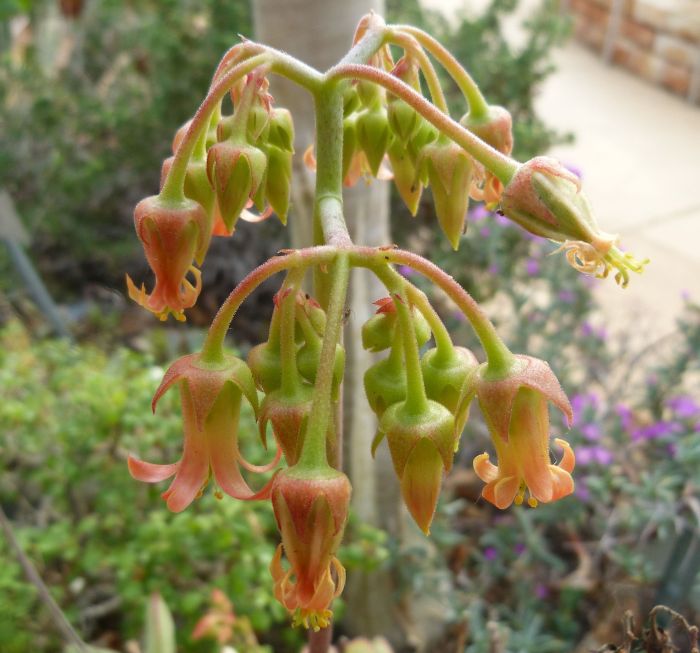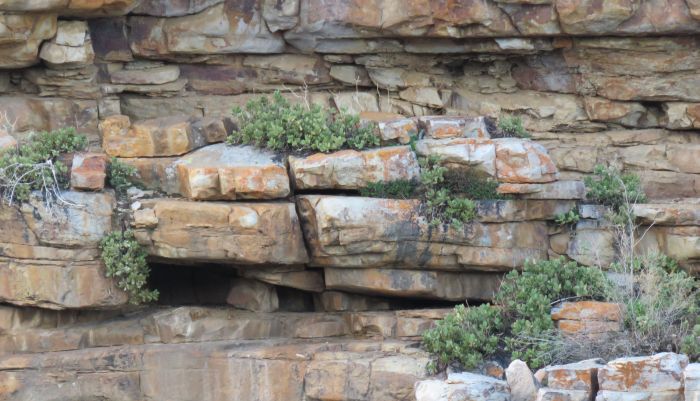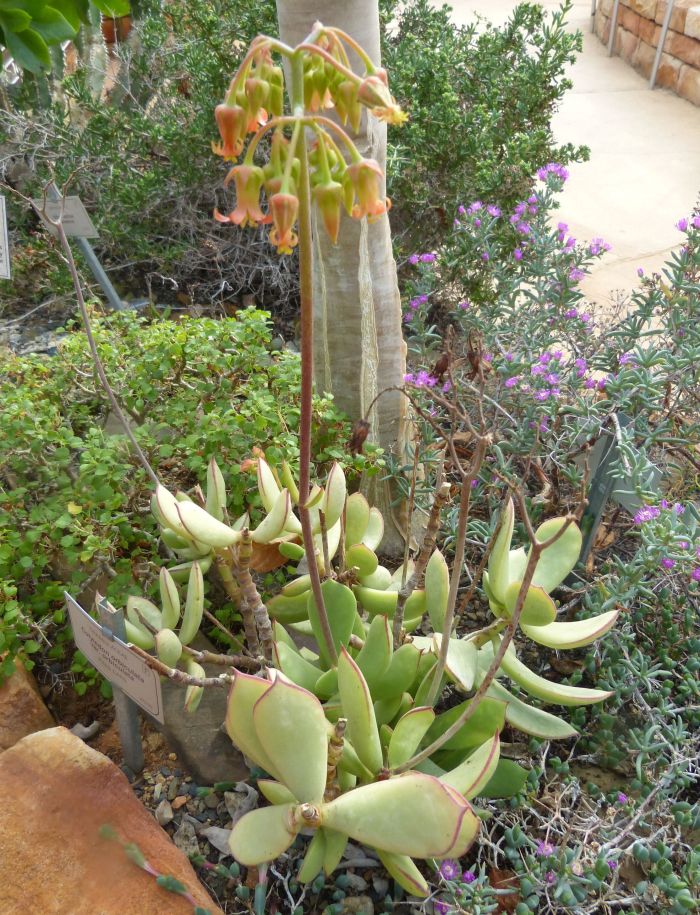Cotyledon tanquana
Cotyledon tanquana Van Jaarsv.
Family: Crassulaceae
Common names: Tanqua cotyledon (Eng.); tankwaplakkie (Afr.)
Introduction
The Tanqua cotyledon (Cotyledon tanquana) is a recently named succulent shrublet from the Tanqua Karoo in the Western Cape. It has sticky, yellowish green, succulent leaves and dull orange flowers. It occurs on the lower western slopes of the Cederberg, growing on cliffs and steep slopes.

Fig. 1. Cotyledon tanquana, illustration (type plant) by Marieta Visagie.
Description
Description
Ascending, much-branched, evergreen, succulent shrublets, 200–600 mm tall (without the inflorescence). The roots fibrous. The branches are 3–6 mm in diameter, grey-green, the lower branches up to 10 mm in diameter, with smooth brownish bark, becoming more woody with age, the nodes about 5–10 mm apart. The leaves are crowded at the ends of the branches, in opposite pairs (decussate), ascending-spreading, flattened, oblong-obovate, 30–65 × 12–25 mm, the base wedge-shaped and with a very short petiole, the surface dull pale to yellowish green and with glandular hairs. The leaf tip can be pointed or rounded with a short hardened point (mucro). The margin towards the tips are reddish.

Fig. 2. Close-up of the leaves of Cotyledon tanquana at Die Mond.
The ascending inflorescence is branched, 150–380 mm long, the peduncle with a single pair of bracts, glandular hairy and purplish mottled. The corolla is pendent, dull orange, 15–17 × 7–8 mm, the tube 10–12 mm long, on pendent flower stalks, 12–25 mm long. The floral parts covered in glandular hairs, the lobes spear-shaped (lanceolate), 17 × 3 mm long, becoming recoiled. The corolla tube not swollen at the base. The calyx lobes are triangular, 5 mm long, 4–5 mm wide and sparsely ciliate.

Fig. 3. Close-up of the inflorescence of Cotyledon tanquana taken in the Botanical Society Conservatory at Kirstenbosch in 2017.
Conservation Status
Status
Although Cotyledon tanquana is rare and confined to a few dry river valleys of the eastern Cederberg, it is quite common in its habitat and consequently it is not threatened and can be regarded as Least Concern (LC).

Fig. 4. The rocky cliff habitat of Cotyledon tanquana at Die Mond.
Distribution and habitat
Distribution description
Cotyledon tanquana is confined to the rocky banks and river valleys of the lower eastern slopes of the Cederberg in the western portion of the Tanqua Karoo, in the Western Cape of South Africa. It is locally abundant where it grows and is mainly confined to cliffs and steep slopes. Plants grow in rocky pockets on south- and north-facing slopes. The geology consists of hard quartzitic sandstone rocks of the Witteberg group (Cape Supergroup) (Johnson et al. 2006). The vegetation of the lower eastern slopes of the Cederberg has been classified as the Swartruggens Quartzite Karoo (Rainshadow Valley Karoo Bioregion) which is part of the Succulent Karoo Biome (Mucina 2006). The plants grow at altitudes of about 400–600 m above sea level.

Fig. 5. A Cotyledon tanquana plant in habitat at Die Mond, Tanqua Karoo (South Africa).
Cotyledon tanquana grows in a semi-arid plant community and associated species observed in the habitat include: Aloe comosa, Tylecodon reticulatus subsp. reticulatus, Crassula deltoidea, C. alpestris subsp. alpestris and C. montana subsp. montana, Antimima sp., Cleretum papulosum subsp. papulosum, Malephora lutea, Scopelogena bruynsii, Psilocaulon sp., Drosanthemum sp. and Gethyllis ciliata. Trees and shrubs include: Codon royenii, Lycium sp., Hymenolepis parviflora, Searsia undulata and Vachellia karroo. Along the river it grows together with Senegalia caffra, Freylinia lanceolata and Salix mucronata subsp. hirsuta.
The rainfall in the habitat of Cotyledon tanquana is mainly in winter, but it occasionally also receives rain in spring and autumn. Precipitation in the habitat is estimated to be about 150–200 mm per annum. The climate is semi-desert with cool to warm winters, with light frosts during the nights. The summers are very hot and dry with occasional thundershowers in spring or autumn.

Fig. 6. A Cotyledon tanquana plant growing at Die Mond on a steep south-facing slope.
Derivation of name and historical aspects
History
Cotyledon tanquana was named by the author in the American succulent journal Haseltonia in 2019, from plants collected in the Tanqua Karoo in 1993 (Van Jaarsveld 2019). Whilst on an expedition to Fraserburg and the Tanqua Karoo with my wife and 2 of our children on October 1993, we joined up with a friend Tielman Haumann, a local Lithops conservationist and expert who wanted to show us 2 species of Lithops endemic to the Tanqua region, as well as the small village Elandsvlei. On our way back Tielman arranged that we also briefly visited the farm Die Mond on the lower eastern foothills of the southern Cederberg in the Tanqua, to observe some San paintings and catch fish. Die Mond (the mouth) is a farm which consists of a shallow rocky gorge, and the confluence of several rivers draining the eastern slopes of the Skurweberg and southern Cederberg. These rivers, the Leeu-, Riet-, Brandkraals- and Matjiesrivier, then join the Doringrivier, the largest river system of the region (Taylor 1996). Along this gorge a Cotyledon was spotted and specimens gathered on 10 October, at the time thinking it was a form of the variable Cotyledon orbiculata.

Fig. 7. Habitat of Cotyledon tanquana at Die Mond.
It was grown in the Botanical Society Conservatory at Kirstenbosch National Botanical Garden since its inception in 1997. Here the plant regularly flowered during winter to spring (August to October, southern hemisphere). The densely branched nature and sticky, cuneate, dull-green leaves and short corolla tube pointed to something unique and upon closer investigation, the plant was found to be distinct and named as a new species. In the winter of 2018, assisted by my wife Erma, Die Mond was re-visited and additional information gathered.
Also, after another hiking expedition to the eastern Cederberg, arranged by Florent Gernier (French naturalist and intrepid explorer) on 18–21 November 2018, accompanied by the author and 2 students Nico van Wyk and Jaco Lategan, the species natural distribution was found to be wider than expected. This expedition on foot was from the farm Nuwerus (Rooi Sederberg), along the river to Die Mond, a route that goes through the heart of the eastern Cederberg. I was thus keen to join and hoping to find more plants. And indeed plants were found on cliffs adjacent to the river all the way to Die Mond farm.
While I was working on the Cotyledon and Tylecodon book (Van Jaarsveld & Koutnik 2004), I was certainly aware of this taxon, but it was omitted because of the uncertainty of its status. Having revisited the habitat and taking into consideration its floral architecture, vegetative features and habitat, I decided to name it as a new species. The flowers for one, are reminiscent of C. tomentosa from the Klein Karoo and further east. The plants have some floral and vegetative features in common. The cliff-dwelling habitat (geology) of this taxon is also somewhat similar. The squamae are presented horizontally, transversely oblong, 2 × 1 mm, which is a unique feature. Squamae are nectar glands at the base of the floral tube. Most parts of the plant are covered in glandular hairs. C. tanquana has dull green leaves, which are distinctly cuneiform, with a glandular hairy surface, causing its stickiness.
The Tanqua Karoo is the closest desert to Cape Town. It lies in a rain shadow between the Cederberg and the escarpment mountains to the east. It has many unique species only confined to this region, which includes 2 species of Lithops (L. comptonii and L. werneri), Tanquana prismaticus, Didymaotus lapidiformis, Cephalophyllum alstonii and Mesembryanthemum clavatum.
The genus Cotyledon was established by Linnaeus in 1753, revised by Toelken in 1985 and also treated by the author in the Illustrated handbook of succulent plants (Crassulaceae) (Eggli 2003). Before 1978, all species of Tylecodon were part of Cotyledon. Toelken separated Tylecodon because of their spirally arranged leaves, becoming deciduous during the summer (Toelken 1978). Tylecodon is by far the largest genus (about 45 species) and is confined to the winter rainfall region.
Cotyledon is evergreen with leaves in opposite pairs. They vary from large shrubs 3 m tall, such as C. velutina, to flat-growing mat forming plants such as C. papillaris. Although Cotyledon grows widespread in drier parts of Africa, their greatest diversity is in the southeastern parts of South Africa The colourful, pendent, tubular flowers are large and conspicuous, and pollinated by sunbirds. The distribution of Cotyledon extends over southern and eastern Africa and as far as the Arabian Peninsula. Most Cotyledon species are endemic to South Africa. Toelken’s treatment (1985) was followed by Koutnik and the author’s book on Cotyledon and Tylecodon (2004), where eleven species have been treated (Van Jaarsveld 1997, 2003). Additional species since Toelken’s 1985 work that have been named, include C. eliseae (Van Jaarsveld 1997), C. pendens (Van Jaarsveld 2003), C. petiolaris (Van Jaarsveld 2015), C. gloeophylla (Van Jaarsveld 2015), C. xanthantha (Van Jaarsveld & Eggli 2017) and C. egglii (Van Jaarsveld 2017). Additionally, C. woodii was enlarged to accommodate the cliff-dwelling subsp. cremnophila (Van Jaarsveld 2015), as well as Cotyledon barbeyi var. soutpansbergensis (Van Jaarsveld 2017). Jacobsen (2017) has also proved that Cotyledon spuria L. (C. orbiculata var. spuria) should be raised again to species level (Toelken 1979). It grows sympatric with C. orbiculata var. orbiculata, differing not only in size and shape but also in their times of flowering. The genus Cotyledon has thus been enlarged and accommodates 17 species.
Ecology
Ecology
Cotyledon tanquana flowers mainly in winter and spring (from August to October). It has been introduced to Babylonstoren Farm where plants can be observed in the succulent house. The dull orange-red, tubular flowers are visited by local sunbirds (Nectarina spp.). After pollination the flowers become erect, and the seed dispersed by wind. Compared to other species of Cotyledon, it is slow growing. The reason for the sticky nature of the leaves, as found in this and other cotyledons such as C. gloeophylla, could be speculated on. It probably immobilizes small insects that are harmful to the plant, and may also supplement the plant’s diet, as both species are associated with mineral-poor, quartzitic sandstone substrate (Adlassnig et al. 2010). Aphids can cause problems and a sticky leaf surface for the insect would result in a certain cul-de-sac.

Fig. 8. Cotyledon tanquana after the severe drought of 2018, at Die Mond.
Plants grow on cliffs and steep slopes out of reach of disturbances, such as those caused by the larger mammals. However, during the severe drought in 2018 many plants suffered badly, with lots of dieback. Their succulent nature enables most of the plants to survive. Cotyledons are known for their chemical defence (cotyledontoxins) which can kill warm-blooded animals (Watt & Breyer-Brandwijk 1962), however, they are a favoured food of the mountain tortoise (Stigmochelys pardalis) and angulate tortoises (Chersina angulata). Because of its cliff habitat and the absence of larger herbivores, it would be interesting to investigate its toxicity to see if there is a reduction in alkaloids.
Cotyledon tanquana was named for the Tanqua Karoo where the plant grows. According to Nienaber & Raper (1983), the name tanqua is probably a variant form of sanqua or sonqua, and pertains to the San Bushmen.
Uses
Use
Apart from growing it as an ornamental, no other local use have been recorded.

Fig. 9. Cotyledon tanquana flowering in the Botanical Society Conservatory, Kirstenbosch, spring 2017.
Growing Cotyledon tanquana
Grow
Cotyledon tanquana, like most cotyledons, is easily grown in dry, semi-arid, Mediterranean climate gardens. However, in a moist climate, the plants should rather be grown indoors under controlled conditions. It is best suited for the succulent karoo garden. Compared to other species of Cotyledon, it is of slower growth but eventually forms a branched shrublet up to about 60 cm high. Plant in a sunny, well-drained site, preferably on a rockery. Cotyledon tanquana can also be grown in some shade and plants look at their best when grown in groups. Well-grown plants in container can also be stunning. In cultivation, water well in autumn and winter, but sparingly in summer. Adding an organic fertilizer to the watering, enhances their growth performance. The Tanqua cotyledon has been grown with success in the Botanical Society Conservatory at Kirstenbosch since its inception in 1997, faithfully flowering during winter months and where the plants can be seen.
Propagate from cuttings of about 8–12 cm in length. This can be done at almost any time of the year, but best in autumn or spring. Remove the lower leaves, and plant in a sandy mixture and keep moist until well rooted. In a dry climate, cuttings can also be planted in situ.
References
- Adlassnig, W. Lendl, T. Peroutka, M. & Lang, I. 2010. Deadly glue – adhesive traps of carnivorous plants. In J. Byern, I. Grunwald (eds), Biological adhesives: from nature to technical and medical application. Springer, Vienna. Pp. 15– 28.
- Clarke, H. & Charters, M. 2016. The illustrated dictionary of southern African plant names. Flora & Fauna Publications Trust, Jacana, Johannesburg.
- Eggli, U. (ed.) 2003. Illustrated handbook of succulent plants: Crassulaceae. Springer, Berlin.
- Jacobsen, N. 2017. Eine Neuebewertung des Status von Cotyledon orbiculata var. spuria (L.) Toelken. Avonia 35(2): 198–201.
- Johnson, M.R., et al. 2006. Sedimentary rocks of the Karoo Supergroup. In M.R. Johnson, C.R. Anhaeusser & R.J. Thomas (eds), The geology of South Africa: 463–501. Geological Society of South Africa, Johannesburg Council for Geoscience, Pretoria.
- Linnaeus, C. 1737. Genera plantarum. Salvius, Stokholm.
- Mucina, L. & Rutherford, M.C. (eds) 2006. The vegetation of South Africa, Lesotho and Swaziland. Strelitzia 19. South African National Biodiversity Institute, Pretoria.
- Nienaber, G.S. & Raper, P.E. 1983. Hottentot (Khoekhoen) place names. Butterworth Publishers, Durban.
- Taylor, H.C. 1996. Cederberg Vegetation and Flora. Strelitzia 3. National Botanical Institute, Brummeria, Pretoria.
- Toelken, H.R. 1978. New taxa and combinations in Cotyledon and allied genera. Bothalia 12(3): 377–393.
- Toelken, H.R. 1979. A re-evaluation of the Cotyledon orbiculata complex. Bothalia 12(4): 615–620.
- Toelken, H.R. 1985. Crassulaceae. Flora of Southern Africa 14: 1–229.
- Van Jaarsveld, E.J. 2015. Cotyledon gloeophylla, a new species from the Kouga River, Eastern Cape. Bradleya 33: 180–184.
- Van Jaarsveld, E.J. 1994. The distribution of Tylecodon and Cotyledon (Crassulaceaea) in south Arica and Namibia, pp. 1157–1163. In: Proceedings of the 13th Plenary Meeting of AETFAT Congress, Zomba, Malawi.
- Van Jaarsveld, E.J. 2003. New cliff-dwelling Crassulaceae from the Eastern Cape: a new Cotyledon and two new Adromischus taxa from the Mbashe and Mzimvubu Rivers, South Africa. Aloe 40: 2: 36–39.
- Van Jaarsveld, E.J. 2010. Water wise gardening. Struik, Cape Town.
- Van Jaarsveld, E.J. 2015. Cotyledon petiolaris, a new cliff-dwelling species from the Eastern Cape South Africa. Bradleya 33: 21–16.
- Van Jaarsveld, E.J. 2015. Cotyledon woodii subsp. cremnophila, a new cliff dwelling taxon from the Kei River, Eastern Cape, Republic of South Africa. Haseltonia 21: 77–79.
- Van Jaarsveld, E.J. 2017. Cotyledon egglii, a new species from the Barberton region, Mpumalanga, South Africa. Bradleya 35: 179–184.
- Van Jaarsveld, E.J. & Eggli, U. 2017. Correction of a nomenclatural problem in Cotyledon. Bradleya 35: 71.
- Van Jaarsveld, E. & Koutnik, D. 2004. Cotyledon and Tylecodon. Umdaus Press, Hatfield, Pretoria.
- Van Jaarsveld, E.J. & Koutnik, D. 1997. New Cotyledon and Tylecodon species (Crassulaceae) from the Cape Province. Bradleya 15: 65–72.
- Van Jaarsveld, E.J. & Van Wyk, A.E. 2017. Cotyledon barbeyi var. soutpansbergensis, a new cliff-dwelling succulent from Limpopo, South Africa. Aloe 47,1: 18–20.
- VAN WYK, A.E. & SMITH, G.F. 2001. Regions of floristic endemism in southern Africa. A review with emphasis on succulents. Umdaus Press, Hatfield, Pretoria.
- Watt, J.M. & Breyer-Brandwijk, M.G. 1962. The medicinal and poisonous plants of southern and eastern Africa , edn 2. Livingstone, Edinburgh & London.
Credits
Ernst van Jaarsveld
Kirstenbosch National Botanical Garden (Retired 2015)
Babylonstoren Farm
Extraordinary senior lecturer and researcher,
Department of Biodiversity and Conservation, University of the Western Cape
August 2020
Plant Attributes:
Plant Type: Succulent
SA Distribution: Western Cape
Soil type: Sandy, Loam
Flowering season: Winter
PH: Acid, Neutral
Flower colour: Orange
Aspect: Full Sun, Morning Sun (Semi Shade), Afternoon Sun (Semi Shade)
Gardening skill: Challenging
Special Features:
Horticultural zones








Rate this article
Article well written and informative
Rate this plant
Is this an interesting plant?
Login to add your Comment
Back to topNot registered yet? Click here to register.